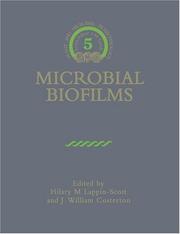| Listing 1 - 10 of 247 | << page >> |
Sort by
|

ISSN: 00766879 ISBN: 0121822117 9786611118907 1281118907 0080548725 9780121822118 Year: 1999 Volume: 310 Publisher: Amsterdam: Elsevier,
Abstract | Keywords | Export | Availability | Bookmark
 Loading...
Loading...Choose an application
- Reference Manager
- EndNote
- RefWorks (Direct export to RefWorks)

ISSN: 18639607 ISBN: 9783540680215 9783540680222 3540680217 Year: 2007 Volume: 1 Publisher: Berlin Heidelberg Springer Berlin Heidelberg
Abstract | Keywords | Export | Availability | Bookmark
 Loading...
Loading...Choose an application
- Reference Manager
- EndNote
- RefWorks (Direct export to RefWorks)
This book details the widely accepted hypothesis that the majority of bacteria in virtually all ecosystems grow in matrix-enclosed biofilms. The author, who proposed this biofilm hypothesis, uses direct evidence from microscopy and from molecular techniques, presenting cogent reasons for moving beyond conventional culture methods that dominated microbiology throughout the last century. Bacteria grow predominantly in biofilms in all natural, engineered, and pathogenic ecosystems, and this book provides a solid basis for the understanding of bacterial processes in environmental, industrial, agricultural, dental and medical microbiology. Using a unique "ecological" perspective, the author explores the commensal and pathogenic colonization of human organ systems.

ISBN: 0521454123 Year: 1995 Publisher: Cambridge : Cambridge university press,
Abstract | Keywords | Export | Availability | Bookmark
 Loading...
Loading...Choose an application
- Reference Manager
- EndNote
- RefWorks (Direct export to RefWorks)
Dissertation
ISBN: 9789090260990 9090260994 Year: 2011 Publisher: S.l. : s.n.,
Abstract | Keywords | Export | Availability | Bookmark
 Loading...
Loading...Choose an application
- Reference Manager
- EndNote
- RefWorks (Direct export to RefWorks)
Book
Year: 2022 Publisher: London : IntechOpen,
Abstract | Keywords | Export | Availability | Bookmark
 Loading...
Loading...Choose an application
- Reference Manager
- EndNote
- RefWorks (Direct export to RefWorks)
Bacterial biofilms are colonies of bacterial cells embedded in their self-produced matrix composed of polysaccharides, DNA, and proteins. They protect bacterial cells against antibiotics, antibacterial agents, soaps and detergents, and shear stress. Some of the most common biofilm-associated infections in humans include urinary tract infections, infection of wounds and surgical sites, diabetic foot ulcers, dental caries (tooth decay) and gingivitis (gum inflammation), ventilator-associated infections, sinusitis, microbial keratitis, secondary infection related to Covid-19 and other viral infections, and so on. Bacterial resistance to common antibiotics (e.g., penicillin, gentamycin, erythromycin, ciprofloxacin, etc.) is driving us to a catastrophic failure of our health systems. Strategies to develop novel antibacterial agents and technology must be prioritized to combat and eradicate biofilms and their associated challenges. This book provides a comprehensive overview of biofilms with chapters on bacterial virulence factors, quorum sensing in bacteria, antimicrobial resistance in bacteria, strategies to develop new antibacterial agents, and much more.
Book
Year: 2022 Publisher: Basel : MDPI - Multidisciplinary Digital Publishing Institute,
Abstract | Keywords | Export | Availability | Bookmark
 Loading...
Loading...Choose an application
- Reference Manager
- EndNote
- RefWorks (Direct export to RefWorks)
Fungal infections are an important and increasing global threat, carrying not only high morbidity and mortality rates, but also high healthcare costs. Without an effective response, it is predicted that 10 million people will die per year as a result of multi-drug-resistant pathogens. A high percentage of the mortalities caused by fungi are known to be biofilm-related.This Special Issue, "Fungal Biofilms 2020", is intended to cover the state of fungal biofilm research, from virulence and pathogenicity, to new compounds with antibiofilm and antifungal activity. We welcome reviews and original research articles covering the development/evaluation/validation of recent studies, especially those regarding multidrug resistance.
Book
Year: 2020 Publisher: London : IntechOpen,
Abstract | Keywords | Export | Availability | Bookmark
 Loading...
Loading...Choose an application
- Reference Manager
- EndNote
- RefWorks (Direct export to RefWorks)
Throughout the biological world, bacteria thrive predominantly in surface-attached, matrix-enclosed, multicellular communities or biofilms, as opposed to isolated planktonic cells. This choice of lifestyle is not trivial, as it involves major shifts in the use of genetic information and cellular energy, and has profound consequences for bacterial physiology and survival. Growth within a biofilm can thwart immune function and antibiotic therapy and thereby complicate the treatment of infectious diseases, especially chronic and foreign device-associated infections. Modern studies of many important biofilms have advanced well beyond the descriptive stage, and have begun to provide molecular details of the structural, biochemical, and genetic processes that drive biofilm formation and its dispersion. There is much diversity in the details of biofilm development among various species, but there are also commonalities. In most species, environmental and nutritional conditions greatly influence biofilm development. Similar kinds of adhesive molecules often promote biofilm formation in diverse species. Signaling and regulatory processes that drive biofilm development are often conserved, especially among related bacteria. Knowledge of such processes holds great promise for efforts to control biofilm growth and combat biofilm-associated infections. This volume focuses on the biology of biofilms that affect human disease, although it is by no means comprehensive. It opens with chapters that provide the reader with current perspectives on biofilm development, physiology, environmental, and regulatory effects, the role of quorum sensing, and resistance/phenotypic persistence to antimicrobial agents during biofilm growth.
Book
ISBN: 9781466559592 Year: 2014 Publisher: Boca Raton : CRC Press, Taylor & Francis Group,
Abstract | Keywords | Export | Availability | Bookmark
 Loading...
Loading...Choose an application
- Reference Manager
- EndNote
- RefWorks (Direct export to RefWorks)
Book
Year: 2014 Publisher: Basel, Switzerland : MDPI AG - Multidisciplinary Digital Publishing Institute,
Abstract | Keywords | Export | Availability | Bookmark
 Loading...
Loading...Choose an application
- Reference Manager
- EndNote
- RefWorks (Direct export to RefWorks)
Book
ISBN: 9781904455967 Year: 2012 Publisher: Norfolk, UK. ; Caister Academic Press,
Abstract | Keywords | Export | Availability | Bookmark
 Loading...
Loading...Choose an application
- Reference Manager
- EndNote
- RefWorks (Direct export to RefWorks)
| Listing 1 - 10 of 247 | << page >> |
Sort by
|

 Search
Search Feedback
Feedback About UniCat
About UniCat  Help
Help News
News